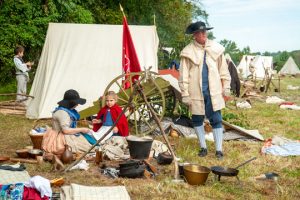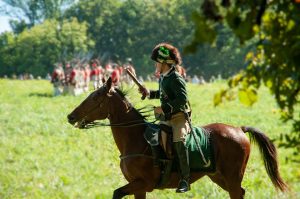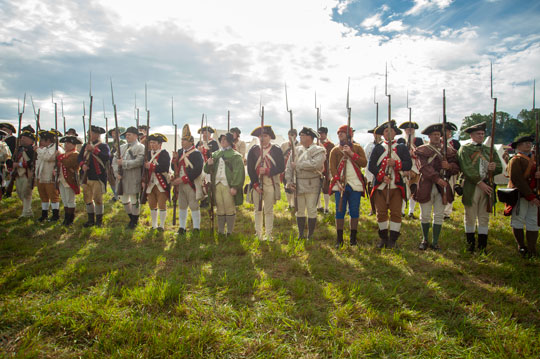The tattoo of the drum, the lilt and melody of the fife, and the haze of spent gunpowder drifted over Sandy Hollow this past weekend. More than 800 reenactors — military and civilian — commemorated the 245th anniversary of the Battle of Brandywine in the same location where the bulk of the actual battle was fought in 1777.
Brandywine was the largest land battle of the War of Independence with an estimated 30,000 troops engaged in a day-long fight in the Birmingham and Chadds Ford areas. The British won the battle, but it delayed the British from capturing Philadelphia, giving members of the Continental Congress the chance to flee the city before they could be caught and, likely, hanged for treason.

The battle had further significance because, while Gen. William Howe had his British troops here, they were not at Saratoga, which enabled the colonials to win that battle. And that, in turn, helped convince the French to enter the war on the side of the Americans.
Scott Boorse, the supervisors’ chairman in Birmingham, said the battle is significant for his township.
He said the battle “means the historical culture of our township. Birmingham is very lucky to have almost the entire Battle of Brandywine fought in the township.”
Boorse is also appreciative of the fact that the township has been able to preserve the open space of the actual battlefield, “so that we can actually “remember the lives that were lost and the freedom that was won.”
Reenactors think along the same lines, though their focus is not so much on the location, but on the historical significance of the battle and the ultimate secession from Great Britain.
Spearheading the two-day event was Randell Spackman, the owner of Thornbury Farm where some of the action was fought during the war, and the president of the Chadds Ford Historical Society. He called the event a “complete immersion in history.”

He said he hopes that the visitors take away some understanding of the history and are moved that they were taken back in time.
“We want people to hear the music, smell the smoke from the cannon, being around the 18th century. There’s no better place to be completely enveloped by it. If you can walk away having been moved by a sense of what happened here on this hallowed ground, I think we’ve achieved our goal.”
Lynn Reilly and Troy Gaines came up from Virginia to take part.
Reilly, from Haymarket, Va., portrays a camp follower for the 43rd Regiment of Foot. She said it was a family-oriented decision since she got involved because of her son, Dillon Reilly. It began a year ago when he was only 10 when he became enthralled with 18th century history.
“He’s a musician, a drummer, and wanted to become a reenactor. He researched which regiments allowed children to participate, and he got me on board with him,” she said.

Reilly continued, saying she’s learned a lot of history during this last year of reenacting, how everyone has a part to play, whether you’re a soldier or a camp follower.
“No one is of more importance than another. You might have British officers directing troops, but you also need camp followers who mend clothing and cook. It’s sort of a circle of community,” Reilly said. “It’s an amazing community.”
She added that her son loves the reenacting and he’s learning a lot about the history of the time. It has also broadened him in other ways.
“He’s met a wonderful, eclectic group of people that if you’re in school or in sports all the time, you don’t get the chance to have that exposure.”
Troy Gaines, a member of the 71st Regiment of Foot, is from Richmond, Va. And has been reenacting for 15 years.
“We’re making memories here,” he said. “It’s all about camaraderie and fellowship that goes along with it, and reliving history.”

He said he’s attracted to the time period because “it’s about the founding of America and all the people who gave their lives for our freedom. The history books are a little dry, especially for children. So, getting out here on the actual fields of battle where these things occurred, it means a lot to those of us who are out here reenacting today to keep history alive.”
One of the things Gaines said he’s learned in his 15 years of reenacting is that “all sorts of people were involved in attaining the freedom of the United States of America, people of all colors, all nationalities. When you get into the history books and look at that, it means a lot to the American fabric. So many different types of people participated in the freedom of this nation.”
Dave Gibson, reenacting for five years, came down from Massachusetts. He said being on the actual battlefield hits hard.
“When you’re on a battlefield where you know these men were, you can relate back and realize this is where they walked, what they walked through. This is where they sat. This is where they had a conversation. Back in Boston, there are a lot of colonial taverns where you can go in, sit down, and know that Paul Revere was sitting in that room. That’s pretty cool.”
About Rich Schwartzman
Rich Schwartzman has been reporting on events in the greater Chadds Ford area since September 2001 when he became the founding editor of The Chadds Ford Post. In April 2009 he became managing editor of ChaddsFordLive. He is also an award-winning photographer.




Comments